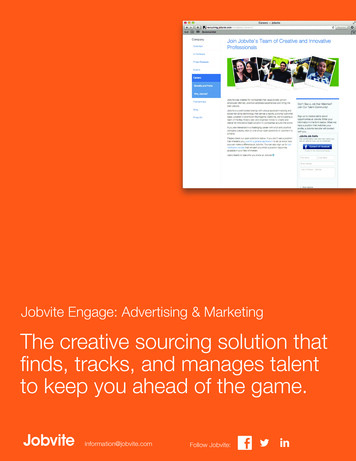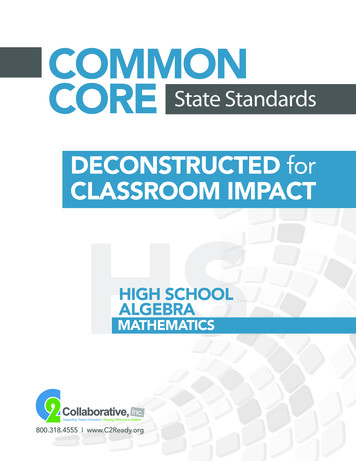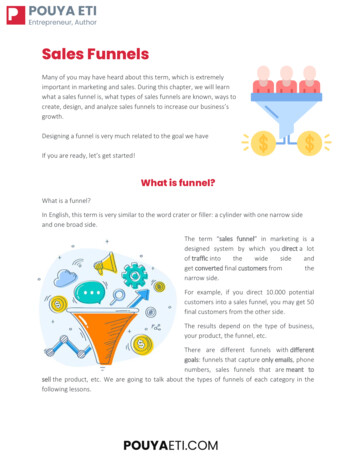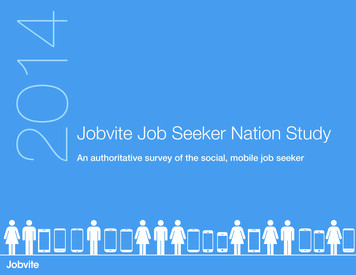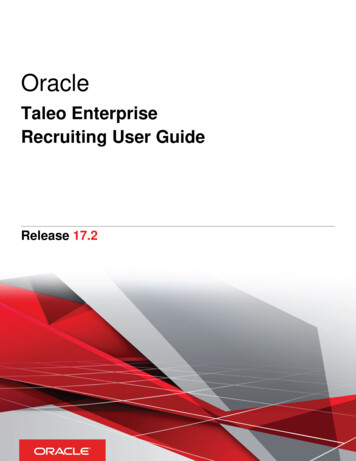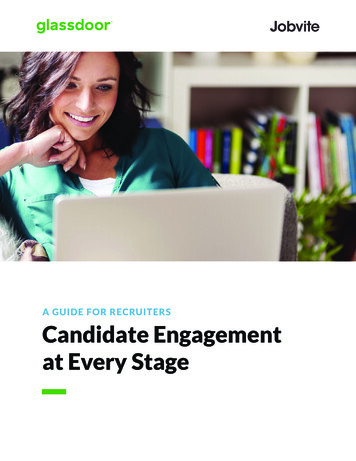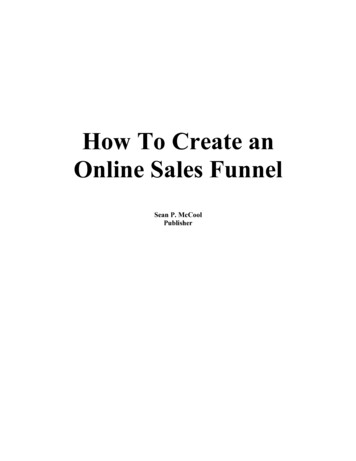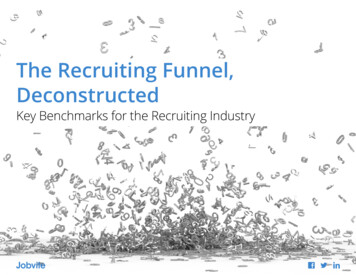
Transcription
The Recruiting Funnel,DeconstructedKey Benchmarks for the Recruiting Industry
The Recruiting Funnel, DeconstructedIntroductionPage 2New technologies, big data, and access tocandidate information are revolutionizingthe recruiting world.This explosion in the amount of information is similar to theboom the marketing world saw in the early 2000’s with theintroduction of customer data. Now that recruiters finally haveaccess to the same types of information as marketers, it’sbecoming more clear that recruiting is marketing. Whereas themarketing world immediately saw the value in this data andlatched onto technologies that could leverage the information,the recruiting world is just catching up. The proliferation ofCRMs has revolutionized marketing and business development.Creating and maintaining relationships has always been part ofa sound business strategy, but that nebulous process has nowbeen operationalized through software like Salesforce. Thereis a reason the CRM software market has boomed to over 20billion.it works. Personalizing the process to maintain constantcontact and build relationships has been shown to be extremelyeffective in converting leads to sales.1
The Recruiting Funnel, DeconstructedHow can recruiters adapt the wisdom and the tools ofmarketing to simplify and improve hiring?This is where the recruiting funnel comes in. If a marketingprofessional’s goal is sales, yours is hires. What is the mosteffective way to reach out to candidates and successfullyconvert them to applicants and eventually hires? This questionis more relevant than ever when we consider the increasinglytransient and tight labor market: 20-24 year-olds have anaverage job tenure of 16 months2 and there are three online jobpostings for every out of work computer professional.3 The valuein good recruiting goes far beyond just rapid hiring: makingthe right decisions when bringing on employees is essential tofuture stability, revenue and growth.4 By using the recruitingfunnel as a framework, this difficult question becomes mucheasier to answer. Breaking down the often long and tortuousprocess from sourcing to hiring into a series of more definedsteps can help to create a series of smaller goals and tasks.These smaller steps create opportunities for you to use metricsto assess what works and what does not, so you can constantlytweak and improve your recruiting process.Page 3So what is the recruiting funnel and why should you use it?It is a framework for the entire recruiting process to create anever-ending pipeline of candidates so you can find the rightpeople for the right jobs in your company. The five steps of therecruiting funnel are: Employment Brand, Sourcing, CandidateExperience, Candidate Selection, and Insight. In each of thesesteps, you are engaging with talent to build relationships andnetworks that will help you to better source, identify, and hirethe best candidates. Recruiting in an increasingly tight talentmarket, with unemployment hovering around 5%,5 it is moreimportant than ever to have an effective plan to engage withcandidates.We will take you through the recruiting funnel framework to seehow each step is an essential component of the whole processand give you strategies to establish and improve your ownfunnel. Drawing on Jobvite’s massive database of more than 50million jobseekers and 10 million applications, this guide willnot just give guidance, but will provide funnel conversion ratebenchmarks, so you can compare and track the performance ofyour recruiting funnel.
The Recruiting Funnel, DeconstructedEmploymentBrandingWith unemployment at its lowest rate inyears, it is more challenging than everto reach top talent.You will need to engage these potential candidates from everyangle, through both active and passive sourcing strategies. Butbefore you get ahead of yourself, with how you will be reachingout, you should first define what message you will be using.This begins with employment branding. Having a consistent,engaging employment brand is the first step to establishinga successful recruitment funnel. In LinkedIn’s 2014 TalentTrends Report, 56% of respondents listed employment brandas THE most important factor in considering a new job.6 Sonow that you know the importance of a great employmentbrand, let’s see how to develop one.56 44 APage 456%THE COMPANY HAS A REPUTATION ASA GREAT PLACE TO WORK20 80 A20%17 83 ATHE COMPANY HAS A REPUTATION OFGREAT PRODUCTS AND SERVICES17%THE COMPANY HAS A REPUTATIONFOR GREAT PEOPLE7 93 A7%THE COMPANY HAS A REPUTATIONFOR BEING PRESTIGIOUS
The Recruiting Funnel, DeconstructedRichard Mosley, the man who literallywrote the book on the employer brand,lays out useful steps to assess andimprove your brand :71. Take stock of your present reputation and exposure as anemployer. Larger firms may use research firms to presenta comprehensive picture, but you can just as easily accesssocial media or job review sites to get a quick survey ofprevailing opinions. Do not let the size of your company oravailable resources discourage you; a recent survey of smallcompanies (less than 1,000 employees) found that “36%held focus groups, 25% used employee surveys, and 13%conducted social media audits.”82. Once you’ve surveyed the talentscape to measure yourbrand, lay out a comprehensive and attainable “EmployeeValue Proposition.” Why should a candidate want to work foryou?3. Now that you have established the key criteria for yourbrand messaging, share it! Use your own social mediachannels to give a view into the employee experience andseek both social and conventional media coverage tohighlight particular perks. Workplace innovators Nextjumpoffer an excellent example of how to not just build a greatemployment brand, but how to publicize it too. In a recentPage 5study, Employment Branding International found that theproportion of companies using social media to promotetheir employment brand has grown 4x, to 76%.94. Lastly, it is not just your job as HR or recruiting managerto be the sole evangelist for your brand. Make sure yourcolleagues and employees have an understanding of whatmakes you special. There is no better way to get youremployment brand message out than via word of mouth.As you can see from these four steps, the main sourcesof material for your employment brand are the employeeexperience and the candidate experience (and of course, howthey are perceived).10All of these elements of employment brand come together onyour career site. As a virtual storefront for jobseekers your siteshould present a welcoming face to talent, not only through aneasy application process, but through specific employee valuepropositions and a window into the employee experience.
The Recruiting Funnel, DeconstructedPage 6Let’s look at some specific data points that highlight how important your career site isas a gateway to your employment brand: The workforce is getting younger and more integrated with technology, so your career site should keep up. Jobvite’s Annual JobSeeker Nation Study revealed that among Millenials, 33% want the ability to apply for jobs on mobile and 26% identified timeit takes to complete an application as the most important factor in applying.11 Optimizing your career site for mobile and quickapplications will help you stay ahead of our competitors to connect with top talent. Career sites are still one of the top sources for quality hires. Jobvite’s database of 50 million job seekers and more than 10 millionapplications shows that career sites account for 34% of applications and 22% of hires. Simple UI’s and informative content canmake an outstanding first impression with your future colleagues. Jobvite’s Job Seeker Nation Study found that in addition compensation, candidates were choosing companies based on: worklife balance (38%), health benefits (36%), growth opportunities (35%), and culture (21%).12 By presenting an integrated messagethat introduces talent to company culture, benefits, workplace, and employee experience you are not only introducing futureemployees, but spurring excitement among applicants and their networks. Your employment brand feeds directly into candidateexperience, so make sure to start off right.In the next two stages of the recruiting funnel, we’ll take a more in-depth look at how improving both employee and candidateexperience can provide benefits far beyond your employment brand. The relationship between all of these components makes it clearhow important it is to align all the steps of your recruitment funnel to create a healthy candidate pipeline.
The Recruiting Funnel, DeconstructedPage 7SourcingYou may have drawn in some new applicants with your improved employment brand,but the next step in the recruiting funnel is crucial to developing a healthy pipeline oftalent. Let’s take a deeper look at sourcing.Finding the right talent is no longer just a problem of decidingwhether to cast a wide net or narrow your search. On topof the tighter labor market, individuals are also jumpingbetween companies more often than ever before. On average,millennials will hold 15 to 20 jobs in their careers!13 With suchhigh variability in the marketplace it is important to have adynamic sourcing process that allows you to keep up withtalent and engage with them whether they are active or passivecandidates. The goal should be to create multiple candidatestreams to give you an increased pool to hire the most qualifiedapplicant.For years the ATS has been the recruiters answer to the CRM. Aconventional ATS can only store data, showing you the status ofan applicant, but forcing you to go to other software to act onyour information and actually connect with candidates.On theother hand, CRM software empowers you to engage with leadsand customers through integrated communication and trackingtools. Yet, just as the lines between marketing and recruitingare blurring, so are the lines between these two pieces oftechnology. A combination of ATS and CRM is the ideal. Aplatform that is specially built for recruiters with all of the toolsyou need to track a candidate’s application process, while alsoempowering you to reach out and develop relationships withtalent.The advent of social recruiting has made hiring a processwhere engagement is key.Whether you are reaching talent through your social mediachannels, email blasts, or direct correspondence, you needto cultivate relationships in order to build a steady pipeline.This is why some new recruiting software is being branded asCRM as well - only here, the “C” stands for candidate insteadof customer. With multiplying means of contact, it is moreimportant than ever to have a platform to help you keep trackof your relationships with all candidates. You can really begin tosee clear results when you look at your sourcing numbers, butwe will see as we move through the funnel recruiting is morelike marketing and a simple ATS just won’t do any longer. Atthis step in the funnel we will move beyond ineffective sourcingtechniques by showing the power of a platform that functionsas both CRM and ATS.
How to Choose Your Applicant Tracking SystemACTIVE RECRUITING is a multi-channel strategy in which arecruiter will intently pursue talent through posting jobs towebsites, search their networks, attend events, etc. to builda steady pipeline of applicants. Some examples of activerecruiting are:Social Job DistributionJobvite’s 2014 Social Recruiting Survey showed that 73% of recruitershave hired candidates through social media. By actively engaging withyour company’s social media followers through job postings or employerbranding content, you are appealing to a pre-selected audience that hasalready shown interest in your brand. Using your ATS to post directly to yoursocial media platforms, you can better track what social networks not onlyyour best applicants, but your best hires are sourced from.Job Boards & Career SitesJob boards (43%) and career sites (34%) are still the largest sources ofapplications, but when you look at the number of hires, these sources donot necessarily produce the most quality hires.14 Developing an effectivefunnel is not just about the number of candidates, but the quality ofcandidates. However, these two outlets for sourcing active candidates canstill be useful. Analyzing sufficient applicant data through your ATS can helpyou target better candidates in the future with more targeted ads or postingon more specific job boards.Page 8
The Recruiting Funnel, DeconstructedPage 9PASSIVE RECRUITING is a strategy whereby recruiters will build their pipelinethrough talent-initiated actions in which applicants will seek out the companyor recruiter. This can also include appealing to your own company to initiateinternal hires. Some examples of passive recruiting are:ReferralsA happy employee is doubly valuable to any recruiter. First,they are more loyal to the organization and will typically havea longer tenure, thus reducing the risk of employee turnoveryou have to spend time and money on. Secondly, they aregreat ambassadors for your company and can be a greatsource for referrals. This impact is amplified in the new age ofsocial recruiting where employees can push jobs to their socialnetworks. By empowering employees to refer friends, you arecapitalizing on the employee multiplier effect and dramaticallyboosting your company’s social reach. Efforts to improve youremployment brand by enhancing the employee experience cansupport your sourcing efforts by driving referral applications,while creating exciting, yet realistic workplace expectations toreduce turnover.Past CandidatesIf a candidate has applied and been rejected, they clearlyhave an interest in the company and are worth keeping onfile to follow-up with. Your ATS should provide broad metricsto nurture campaigns to connect with past candidates andkeep them interested in your organization. Engaging withpast candidates can create a new talent stream of passivecandidates. In the age of “job shoppers” it is more importantthan ever to monitor past candidates. A recent Jobvite surveyfound that 45% of job seekers who are satisfied in their currentjobs are also open to new ones.15 Someone who may have notbeen the right fit 6 months ago could have acquired the skillsfor the position you are trying to fill.Social Media and YourEmployment BrandSocial media is not just for job distribution for active candidates,but it is also a great way to get your company in front of passivecandidates. Updates on workplace improvements or posts thatshow company culture can entice a candidate who may havebeen on the fence about seeking employment outside of theircurrent position. A recent Glassdoor survey showed that 94% ofrespondents “are likely to apply to a job if the employer activelymanages their employer brand.”16
The Recruiting Funnel, DeconstructedSourcing is becoming closer and closer to a quantified science, and with a dynamic (oreven predictive) ATS to can track where candidates come from and identify successfulengagement techniques, you can begin to pare down to only the most effective practices.Of course once you have attracted the candidates it is important to create a comfortableand easy to understand candidate experience. Let’s move onto the next step in therecruitment funnel to see how you to entice candidates and how to optimize your hiringprocess over time.ACTIVE RECRUITING Social Job Distribution Job Board & Career SitesPASSIVE RECRUITING Referrals Past Candidates Social Media and YourEmployment BrandPage 10
How to Choose Your Applicant Tracking SystemCandidate ExperienceSo you have identified successful sourcingstreams and are swimming in candidates.Now what?To make sure this is a consistent “problem” and to sustain the neverending pipeline, it is important to make sure the candidate has apleasant experience, not just while they are applying and interviewing,but throughout the myriad of ways they are interacting with your brand.Content on social media channels, professional networks, your careersite, and job boards are just some of the ways candidates are interacting.These are all avenues you control, but since we have already coveredsocial recruiting through sourcing, let’s focus in on the application andinterview process.Page 11
The Recruiting Funnel, DeconstructedThe PostingIn a recent TalentBoard survey, the top 5 most importantcomponents of a job posting were: job descriptions, salaryranges, benefit details, successful candidate profiles, and careerpath examples. (source:Jobvite infographic). The overwhelmingtheme here is clarity. By setting accurate expectations, you arepreparing the candidate for what is expected in a successfulapplication, and further down the road - a successful employee.The ApplicationFilling in an application can be a tedious process, and time is ofthe essence for those coveted passive candidates. Put yourselfin your ideal candidate’s shoes. Between work and extracurriculars they have very little free time. Maybe on their wayhome from work, the gym, or an event they browse job listings.Page 12It is in this fleeting moment that you can catch a candidate’sattention and convert their idle interest into an application.An analysis of Appcast data found that application rates dropby 365% if an application takes more than 15 minutes tocomplete.17 Reducing the time it takes to apply is absolutelycrucial. Of course, a quick application should still be wellrounded. While you can simplify applications for positions thatsimply require you to capture as many people as possible, bestrategic when crafting applications for highly-specific positions.Skilled workers for distinct positions may need longer formsand processes to make sure you are getting the right candidate.To strike a balance between these two extremes, assess yourprocess by measuring your conversion rate with differentapplication types.A recent LinkedIn study found that when it comes to mobile,62% of passive candidates have visited a company site to learnabout careers and 53% have browsed career opportunitieson job boards. However, only 24% of these passive candidateshave applied to a job on mobile.18 That discrepancy in views andapplications represents a huge missed opportunity. Optimizingyour mobile site to allow for simple applications, or at the veryleast to contact a company recruiter can be the differencebetween finding the right employee and an expensive, timeconsuming search. A flexible recruiting platform that plugs intoyour existing mobile site or provides the total mobile careerspage experience can turn the application procedure into a oneor two-click affair. A platform that lets a candidate apply withtheir LinkedIn account or a pre-loaded resume can save tons
The Recruiting Funnel, Deconstructedof time - something that is especially necessary for passivecandidates. At the very least you need to provide some wayto apply via mobile, and surprisingly, most applicant trackingsystems today still don’t offer a mobile optimized experience.It is a given that your career site should be responsive to scaleto whatever screen size candidates are using, but equallyimportant is a site that loads fast on every device. A slowloading application leaves you susceptible to higher dropoff. Choose a recruiting platform with mobile optimized andresponsive career pages to make sure your visitors becomeapplicants.The RejectionWe’ll cover how to select the right candidate in the next section,but an often overlooked piece of the recruiting process is thecandidate rejection. If you have posts across several job boards,your career sites, and social media channels you can findyourself inundated with applications--many of which you wouldhave rather not gotten in the first place. But remember, justbecause someone is not the right fit now, doesn’t mean theywon’t be in the future. As we discussed in the sourcing section,in a tight talent market it’s more important than ever to createmeaningful relationships with ALL of your applicants. Even thoseyou are rejecting.Page 13So before you ignore a candidate or send a curt email, a recentTalentBoard survey found that 51% of candidates share agood hiring experience on social media, and 34% share badhiring experiences on social media (source:Jobvite infographic).Ambiguity is often a point of frustration, so be sure to close theloop with candidates, giving them a final decision either througha personal correspondence or your ATS. Providing a respectful,yet firm decision empowersboth recruiters and hiringRemember – themanagers in this difficult partcandidates that youof the process. Each applicantdon’t hire can be evenshould be thought of as a lead.Treat all candidates in a friendly, more damaging thanrespectful manner and you’ll seethe ones you do.your talent grow substantially.We have covered the blurring boundary between an ATSand a CRM and nowhere is that trend more apparent in therecruiting funnel than candidate experience. Creating a positiveexperience by having a clear, simple application process andby acting as a guide to the best candidates will help add toyour pipeline. Nurturing relationships with talent will go beyondeach individual you connect with. By proactively contactingcandidates, you are expanding your recruiting network andcreating a comprehensive talent pool to draw from. The benefitsof this marketing-based approach will be apparent when youreach the next stage of the funnel - candidate selection.
The Recruiting Funnel, DeconstructedCandidateSelectionPage 14How well can you know a person after aresume, cover letter, and interview?Some recruiters and hiring managers think these three informationsources are enough to hire a new employee. However, with the adventof social recruiting and connected recruiting platforms, you can createcandidate profiles that draw on social media profiles, past applicationsand correspondences, and innovative interview technology. Drawing onall of these pieces of data can help with the absolutely crucial task ofselecting a candidate. Let’s look at how each comes into play: The days of jobs@yourcompany.com are over.or at least theyshould be! Downloading resumes from a company email, manuallyentering candidate information into a static excel sheet, and sharingwith your HR team takes valuable time. By using a platform thatallows recruiters and hiring managers to share information about acandidate, each person on your team can offer insights and createa more representative picture of an applicant. Jobvite’s platformhelped ShoreTel through its early growth phase by streamliningthe hiring team’s workflow process. In describing the new software,the company’s corporate recruiter said “candidates are easier totrack . when a task is signed off by one person, it automaticallygoes to the next, so the ball never gets dropped.”19 It is this type ofseamless information exchange that will create an accurate pictureof potential hires.
The Recruiting Funnel, Deconstructed Social media profiles can provide a trove of informationon a candidate. LinkedIn and Facebook profiles can holddata on job history, recommendations, and interests. Usinga recruiting platform that integrates these profiles into acandidate’s application will centralize data and allow you tolook beyond the resume. These social channels can helpyou to better identify a personality-fit in ways that werepreviously impossible. A recent Harvard Business Reviewstudy found that as much as 80% of employee turnover canbe attributed to bad hiring decisions.20 Be sure to use allinformation at your disposal to make the right decision. An average phone interview takes about 30 minutes toconduct, but add to that the time it takes to schedulemultiplied by several candidates and you have spent asignificant amount of your day just to find the time tointerview. Coordinating between hiring managers’ andexecutives’ individuals schedules is a tedious task thattakes you away from recruiting. Jobvite’s smart schedulerincorporates all individual schedules to give you availabilitywindows in a matter of seconds. By streamlining theprocess, you can spend more time to evaluate an interviewinstead of just setting it up. There is no better way to get a sense of a person than anin-person interview. However, coordinating with candidates’schedules (especially valuable passive candidates), buyingflights for non-local interviewees, and setting up complicatedvideo calls can be significant drags on time and money.Culling from Jobvite’s own databases, we found that onPage 15average, a single job posting will get 59 applicants. Withsuch a high number of applicants you may want to interviewthan the average 4 to 6 candidates. Video conferencing candrastically cut down on interviewing costs by saving time andmoney. Video screening can act as an all-in-one interviewthat will eliminate the need for separate phone screens andreduce travel costs. Such savings are even more apparentfor entry level and commoditized roles like customer service,sales, and marketing. While Skype may work fine, using aplatform with integrated video centralizes another pieceof the process so you can have all of your existing datawhile you speak with a candidate and record any updatesfrom your conversation. Recording conversations, trackingcorrespondences, and keeping a centralized database all callto mind marketing, but you can see they are just as valuablein hiring. Connecting with candidates will help to clarifyemployee/employer expectations, assess attitude fit, andensure you’re hiring the right person for the job.
The Recruiting Funnel, DeconstructedInsightPage 16While we have alluded to it throughoutevery step, drawing measurable insightsfrom your process is the absolute key tocreating a successful recruiting funnel.In order to create a never-ending supply of candidates, youwill need to regularly tweak your model to adjust your content,communication, and approach. Your ATS can form the basis of anincredible knowledge base to draw insights on what is and is notworking in your process. Regular reports on how you are sourcingand converting candidates into employees will reveal the parts ofyour recruiting funnel that need improvement. Let’s take a look ata few metrics that can provide each step of the way.
The Recruiting Funnel, DeconstructedEmployment BrandingSourcing Employee Referrals Candidates by ChannelBy focusing on the quality of your workplace, you can driveemployee referrals. Happy employees will recommend theirnetwork to join them, so track the number of employeereferrals after you have implemented employment brandingstrategies to improve your workplace. Social media engagement by post typeUse services like Klout that track social media engagementto see how different types of posts connect with youraudience. Highlighting workplace perks, covering corporatesustainability efforts, or featuring a star employee can boostyour employer brand and drive applicants. Social recruitingtools in your recruitment platform can provide metrics foryou to derive the relative success of campaigns.Page 17To keep a healthy talent pipeline you should alwaysassess where your applicants are coming from. Tracking ifcandidates reached you through job boards, your careersite, or referrals is just the beginning. Digging deeper intothe data to see where your hires come from and whatdevices candidates are accessing your application fromwill lead to more effective recruiting. When you learn fromthese insights, you can direct your time and resources tothe most impactful channels. Use a recruiting platform thatwill aggregate these sources to give you correct data andpresent findings in simple reports. Sourcing mix by job21Different positions get different types of applicants.Important upper-level management jobs will often benefitfrom the types of experienced applicants that are oftenpassive candidates. Go beyond candidates by channel andlook specifically at each job you are posting. Perhaps acertain recruiting technique is working for one posting thatyou can apply to a more pressing position.
The Recruiting Funnel, DeconstructedPage 18Candidate Experience Applications to Interviews Conversion Rate Applications Started vs. Applications SubmittedThe benchmark for applications to interviews is 12%.With this in mind you can assess the quality of candidatesyour posts are bringing in. Specifying qualificationsand expectations can help to weed out under-qualifiedapplicants and draw in serious candidates.There is no better indicator that your candidate experienceefforts are broken than the number of incompleteapplications. When a candidate starts then stops anapplication it is a sign you should simplify the process.Candidate dropoff is especially important when trackingyour mobile application experience. You want to appealto ALL talent, not just active candidates with a tolerancefor lengthy applications. The best potential candidatesoften have the lowest threshold for long and complicatedapplication processes.Passive Candidates24% passive – activeApplications12% apply – interviewActive Candidates15% interview – offerInterviewOffer Accepted89% offer – hired1.6% top – bottom
How to Choose Your Applicant Tracking SystemPage 19Candidate Selection Interview to Hire Conversion RateThe benchmark for interview to hire is 15%. This can be an indicator of either the quality of candidates or the interview process.Bringing in too many applicants for interviews could signal a lack of position clarity or miscommunication among your team. Total offers vs. Total Offers acceptedCurrently, 90% of offers are accepted, however we may expect to see this number fall with the tighter labor market. By havinga centralized database of offer contents, you can compare what compensation levels and benefits have been successful inconverting candidates to employees.The next step in recruiting technology is in the field of predictive a
he Recruiting unne econstructed Page 6 The workforce is getting younger and more integrated with technology, so your career site should keep up. Jobvite's Annual Job Seeker Nation Study revealed that among Millenials, 33% want the ability to apply for jobs on mobile and 26% identified time it takes to complete an application as the most important factor in applying.11 Optimizing your .



